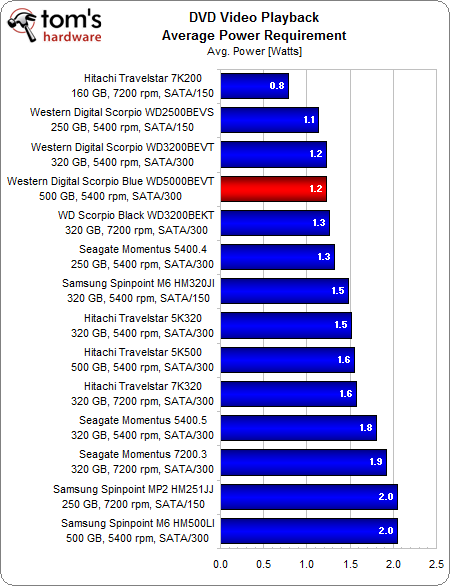Scorpio Blue: Big Notebook HDDs Go Mainstream
Efficiency With Video Playback & Conclusion
Efficiency at Video Playback
Finally, we also looked at the Scorpio Blue’s power consumption when it has to deliver a defined data stream. In the case of this benchmark, this is a MPEG-2 stream for video playback. The 1.2 W result is good, but it could still be better. Hitachi’s Travelstar 7K200 at 160 GB manages to reduce power consumption much further in this mode, reaching an amazing power requirement of just 0.8 W for DVD playback.
Conclusion
We expect new products to outperform their predecessors, and this one does. If we compare the new WD Scorpio Blue 500 GB with its 320 GB forerunner, the new one is significantly faster and more efficient, and it is even cheaper, as drive prices have been decreasing. However, the Scorpio Blue also outperforms all of its 5,400 RPM competitors, with very few exceptions, and we found that it is about as fast as a 2-year old 750 GB Seagate 3.5” desktop hard drive.
This drive required the least power to deliver above average performance, making it the clear winner in our performance per watt benchmarks, and it also achieved nice idle and peak power requirement results. However, the power management seems to be limited by being efficient overall—we did not observe the drive entering a low power idle mode after a longer idle period, nor did its power requirement adjust to limited workloads such as MPEG-2 video streaming.
WD’s new Scorpio Blue offers huge capacities for mobile computing, comes at various popular capacity points, and is quick and efficient. There still is room for improvement when it comes to optimizing power consumption at specific workloads. Is that really necessary? Yes, it is—if WD doesn’t do it, someone else will.
Get Tom's Hardware's best news and in-depth reviews, straight to your inbox.
Current page: Efficiency With Video Playback & Conclusion
Prev Page Efficiency With Streaming Reads